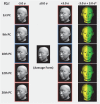Facial cues to age perception using three-dimensional analysis
- PMID: 30759092
- PMCID: PMC6373935
- DOI: 10.1371/journal.pone.0209639
Facial cues to age perception using three-dimensional analysis
Abstract
To clarify cues for age perception, the three-dimensional head and face forms of Japanese women were analyzed. It is known that age-related transformations are mainly caused by changes in soft tissue during adulthood. A homologous polygon model was created by fitting template meshes to each study participant to obtain three-dimensional data for analyzing whole head and face forms. Using principal component analysis of the vertices coordinates of these models, 26 principal components were extracted (contribution ratios >0.5%), which accounted for more than 90% of the total variance. Among the principal components, five had a significant correlation with the perceived ages of the participants (p < 0.05). Transformations with these principal components in the age-related direction produced aged faces. Moreover, the older the perceived age, the larger the ratio of age-manifesting participants, namely participants who had one or more age-related principal component score greater than +1.0 σ in the age-related direction. Therefore, these five principal components were regarded as aging factors. A cluster analysis of the five aging factors revealed that all of the participants fell into one of four groups, meaning that specific combinations of factors could be used as cues for age perception in each group. These results suggest that Japanese women can be classified into four groups according to age-related transformations of soft tissue in the face.
Conflict of interest statement
This study was fully funded by Kao Corporation (http://www.kao.com/) and all authors were permanent employees of Kao Corporation. The methodology was invented and has been patented by Kao Corporation [Face Impression Analyzing Method, Aesthetic Counseling Method, and Face Image Generating Method.] (JPB-5231685, PCT/JP2012/004404). There are no further patents, products in development or marketed products to declare. This does not alter our adherence to all the PLOS ONE policies on sharing data and materials.
Figures






References
-
- Alley T. Social and applied aspects of perceiving faces. New Jersey: Lawrence Erlbaum Associates Ltd; 1988.
-
- Zebrowitz L. Reading Faces. Colorado, Westview Press; 1997. pp. 14–39.
-
- Todd JT, Mark LS, Shaw RE, Pittenger JB. The perception of human growth. Sci Am. 1980; 242(2): 132–144. - PubMed
Publication types
MeSH terms
LinkOut - more resources
Full Text Sources
Medical

